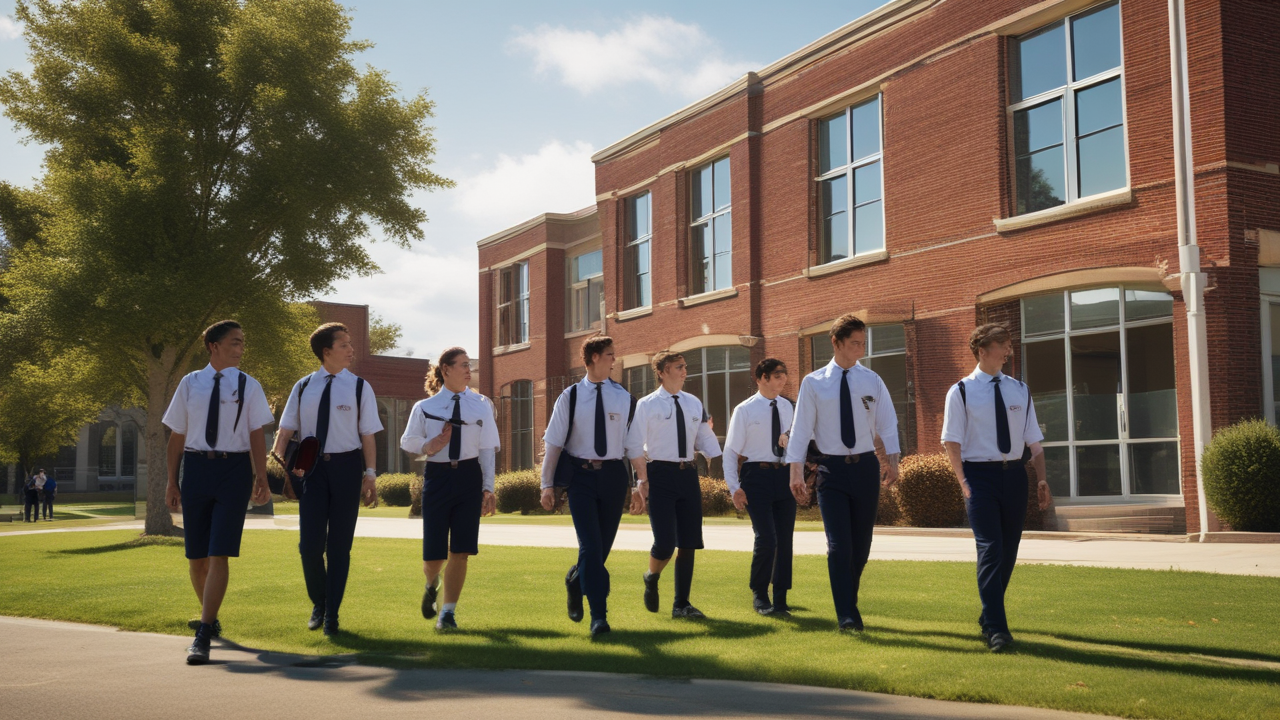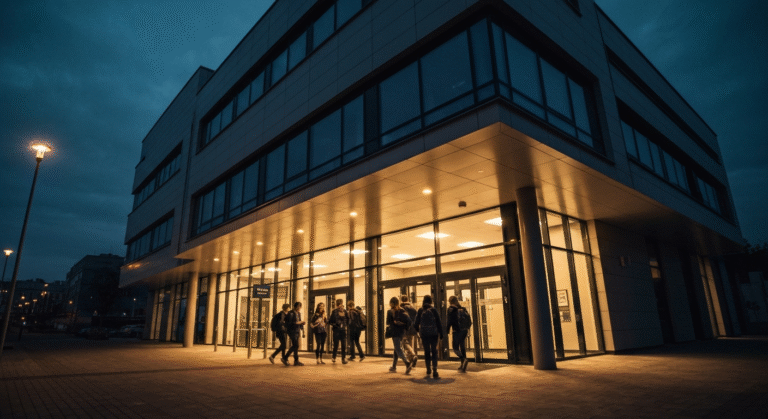Key Highlights of Catholic Schools in Canada
- Catholic schools in Canada are part of a special catholic school system. They often run alongside public education because of rules set up a long time ago.
- Some provinces give public funding to support catholic education. The separate school system is biggest in Ontario, Alberta, and Saskatchewan.
- Catholic schools in Canada blend learning with faith-based lessons. They focus on doing well in school and welcome catholic and non-catholic students.
- The process to get into catholic schools and rules to be eligible change based on which province you are in and what school board is in charge.
- Differences from province to province in how catholic school funding works and how schools are managed make the structure, the curriculum, and how people get in very different across Canada.
- There are ongoing talks over tax money and if it’s fair to give public funding to catholic schools. People ask about fairness, rights for smaller groups, and the level of educational quality.
Introduction
In Canada, there are many ways to go to elementary schools. People here can choose from different education options because the country has a mix of ideas and beliefs. Catholic elementary schools are one part of this system. At these schools, you get to learn about your regular school subjects, but you also learn about faith. They want to help students do well in school and in life. These schools want to help kids grow up with good values that come from Roman Catholic beliefs.
If you look at how Catholic schools started, who runs them, and how they get money, you can see why they are important for education in Canada. Understanding all this shows why Catholic elementary schools matter to people here.
Overview of Catholic Schools in Canada
In Canada, people can choose from many types of schools. Catholic schools are an important part of the school system here. These schools are built on strong religious values. They try to help students do well in their studies and grow spiritually, too. Different school boards run these schools. Catholic schools are part of the main public education system and get public funding. This support shows the value they add to education in Canada. At the same time, they follow both what their religion teaches and the rules set by the province.
Definition and Mission of Catholic Schools
Catholic schools work to give students a good education and help them grow spiritually. In these schools, teachers help catholic students learn and practice their faith every day. The goal is to make a safe place where people care about each other, work together, help others, and feel responsible for the community. Catholic schools really focus on religious education, and the teachings of the catholic church are a big part of what you learn there. In Canada, these schools teach important values like respect, honesty, and being kind. They want catholic students to be ready for school and for everything else in life.
Role of Catholic Schools in the Canadian Education System
Catholic schools play a special role in Canada’s education system. They focus on helping students grow in every way, using a set of values to guide teaching. In these schools, faith is an important part along with strong academics. Teachers encourage students to follow good morals and ethical rules.
Community means a lot in Ontario’s Catholic schools. Students from many backgrounds come here, and both Catholic and non-Catholic families are welcome. The schools have programs that fit the needs of all students. In some parts of Canada, Ontario’s Catholic schools get public funding from the government. This means students in these schools can learn about their faith and also keep up with what each province says students should learn.
Historical Development of Catholic Education in Canada
The story of the history of Catholic schools in Canada started with the first schools in British North America. As time went on, these schools became part of the separate school system. The British North America Act played an important role in this process. The Catholic school system kept growing, and its way of getting funds had to change as laws and society changed. Through everything, the school system worked to keep its focus on faith and learning. Catholic education in Canada is all about helping students grow in both knowledge and belief.
Origins and Constitutional Foundations
The history of Catholic education in Canada started in the early days when Europeans began to settle here, particularly in Upper Canada. Many of these settlers, especially the Irish Catholics, brought their beliefs and ways with them. The British North America Act set the basic rules that allowed smaller religious groups to keep their own schools. This is how separate schools like Catholic schools were able to grow. The Constitution Act made this stronger by saying there must be public funding for Catholic schools. Because of this, Catholic education became a real part of the public education system in Canada. The link between faith and public education was part of the rules from the start, thanks to these laws.
Evolution of Funding and Legislative Changes
Funding for catholic schools in Canada has changed over the years. At first, the separate school system did not get much public funding. Most of the support came from local communities and the catholic church. The British North America Act and, later, the Constitution Act affirmed that these schools had the constitutional right to public funding. This helped make sure tax money was shared in a more fair way between the schools. As a result, more students had access to catholic education, and not just catholic students. Now, the school system helps serve more people, including those who are not part of the catholic church.
Provincial Differences in Structure and Governance
Catholic education in Canada is managed in different ways from province to province. In Ontario, the separate school system makes sure that catholic schools get a lot of public funding. This helps catholic students have good access to education that fits their faith. In Alberta and Saskatchewan, catholic school boards work right beside public school boards. Parents there can choose if they want their kids in catholic schools or public schools. But in Quebec, things are not the same. The province runs a group of publicly funded catholic schools. This way of doing things is shaped by Quebec’s history and culture, which is a bit different from other parts of Canada’s school system.
Ontario’s Separate School System Explained
In Ontario, the separate school system is set up so that both Catholic and public schools get public funding. This is in line with the rules set by the Constitution Act. The school system lets Catholic schools run on their own, but they still have to answer to the provincial government. This helps keep a good balance of religious teachings and regular school lessons. The whole thing is paid for with tax money. That way, students at Catholic schools have the same resources and education as those in public schools.
Catholic Schools in Alberta and Saskatchewan
In Alberta and Saskatchewan, Alberta Catholic schools are an important part of education. The schools get money from the province and local taxes. These schools focus on good learning and also on teachings from the catholic church. Students from different backgrounds go to these schools. The courses mix strong studies with lessons about values from the catholic church. This helps students grow in the classroom and in their faith.
The Unique Case of Quebec and Other Provinces
Quebec’s education system is different from other places in Canada. In 1998, Quebec fully merged its Catholic and Protestant school systems. Now, the system focuses on language instead of religion when it comes to how schools are run. This has changed the funding, too. Public funds for religious education now go to support students from many different backgrounds. On the other hand, places like Alberta and Saskatchewan still keep their school systems separate. These provinces have strong regional ties to catholic education, but the schools still follow the rules set by the province.
Funding Models for Catholic Schools Across Canada
Different ways of funding shape how catholic education looks in Canada. Many publicly funded catholic schools use government money. This can make people talk about how tax money is shared between public schools and catholic schools. Private catholic schools pay for things in another way. They often use tuition fees and get donations. Because of this, people often discuss the reasons and problems with funding catholic schools. This is a bigger topic when thinking about the Canadian Charter of Rights. It aims to make sure all students get equal access to education in both catholic schools and public schools.
Public Funding: Rationale and Controversies
Public funding for catholic schools in Canada has started many strong discussions. Some people say that the separate school system, made long ago to help small groups like Irish Catholics, is a good reason to use tax money for catholic schools. On the other hand, others do not agree. They feel public funding for religious education can make things unfair in the public education system.
There is a problem between what the rules say for religious groups and what is fair for everyone who uses public education. People keep talking about this because there are questions about the future of catholic school funding in Canada. The idea of using public money for the separate school system and catholic schools is not simple, and many still do not know what is best.
Private Catholic Schools and Their Financing
Private catholic schools are separated from the public education system. They depend mostly on tuition fees and money that comes from donations. This way of getting the money gives them more freedom to make their own curriculum and help students in ways that fit best. Many families pick these schools because they want their kids to have good academics and be in a place that teaches faith. Most of what these catholic schools need comes from tuition fees, fundraising, and gifts from people in their area. While some may get a small amount of government funding, they still use what they raise from the people around them to build a strong way to teach.
Curriculum and Faith-Based Integration
One key part of catholic education is mixing faith with what students learn in school. This helps to make a place where teaching about religion fits with what students study in other subjects. Students in catholic secondary schools take religion classes. In these classes, they learn about moral values and working together to help others in the community.
Catholic secondary schools also add spiritual activities alongside their main courses. These activities let students show their faith through what they do every day. Doing this helps build people who are not just strong in learning at secondary schools but also ready to make life better for others.
Religion Classes and Spiritual Formation
Religion classes are a key part of Catholic schools and their main goal. These classes help students learn more about faith and right choices. In these lessons, teachers use different ways to teach. The focus is on topics like doctrine, scripture, and why community matters. Spiritual growth in these schools is not just about what happens in class. Students also take part in service and spend time thinking about their actions. These steps are important for them to grow as people. All this does not just make each student’s beliefs stronger. It also helps build a strong group feeling in Catholic school communities. This way, faith and learning come together every day.
Academic Programs and Provincial Standards
Programs in catholic schools match what the province asks for and also add parts of faith-based education. Each province wants schools to help students grow in both academics and morals. The focus is not only on subjects like mathematics and science. It is also on talking about what is right or wrong, based on catholic values. Religious education is a main part of the daily lessons. This creates something special in catholic schools where catholic school students are inspired to learn and grow in both mind and spirit. It helps them get ready for many paths in life.
Admissions and Enrollment Policies
Enrollment rules at catholic schools show how they want to be open and welcoming. They let both catholic students and students from other backgrounds join in. This helps create a classroom with all kinds of people. Every school board can set its own rules for how you apply, like asking for papers about your time in school and your family’s faith. These steps let families with different beliefs be part of catholic education and learn from the curriculum.
At some private catholic schools, tuition fees are not always the same. The cost can change depending on where you live in Canada, so the chance to get faith-based education can be different in each area.
Eligibility Criteria for Catholic and Non-Catholic Students
Admission to faith-based schools often depends on rules for both catholic and non-catholic students, including the admission to catholic schools in Canada. In most cases, families linked to the Catholic Church by baptism or by being active members find it easier to get in. Yet, these schools also accept non-catholic students. They do this to include more people and show variety among their students. The school boards and the rules of each province say how admissions work. At the same time, schools follow what the Canadian Charter of Rights says. This way, students and families have choices and schools stay fair.
Application Procedures and Documentation Required
The application process for catholic schools can look different than in some other places. You need to follow special steps, and get all your papers sorted. Most of the time, families have to hand in an application form. This form asks for things like the student’s name, birthday, and family details. The school may also want to see proof of baptism or ask for a note from a priest to show the student is part of the Catholic faith. Doing these things is important because it helps you get accepted at catholic schools in Canada. It helps the school know you meet all their rules.
Advantages and Challenges of Attending Catholic Schools
Attending catholic schools can have both good points and tough spots for students and their families. One big benefit is that catholic schools mix faith with learning. This helps catholic students build a strong sense of right and wrong and feel like they belong to a group. But, there are some challenges. The school may not offer a wide range of subjects because it follows certain religious rules. Also, funding for these schools can change, so some have more things for students than others. Knowing about these things can help families make better choices for their kids when looking at the best way for catholic students to grow and learn in the education system.
Conclusion
Looking at catholic schools in Canada, you can see that they offer both faith and learning. These schools have a long history. There is a mix in how they get money. They do not just welcome catholic students. The schools also open doors for those who are not catholic. The mix of religious education with school lessons gives a special feel to how these schools work. This helps students grow in both their minds and their beliefs. In the end, the canadian catholic education system stands on strong values. These values help many students in the country to learn and grow.
Frequently Asked Questions
1. Why are Catholic schools publicly funded in some provinces but not others?
The reason for differences in public funding for catholic schools in each province comes from old agreements, laws, and educational plans. Some provinces have made promises in the past to give public funding for catholic education. Other provinces focus more on non-religious schools. This is why you can see not just changes in public funding, but also in how catholic schools are run in each place.
2. How do Catholic schools in Canada compare to those in the United States?
Catholic schools in Canada get more public funding than private schools in the U.S. Catholic schools in the U.S. mostly depend on tuition and private help to run. Both the U.S. and Canada want to focus on faith-based education. In Canada, these schools many times have their own ways to run things and follow teaching rules that match provincial needs.
3. What resources can help parents choose top-rated Catholic schools?
To find good catholic schools, parents can look at reviews online and school rankings. They can read what people say in community forums and talk to local education groups. It also helps to visit schools during open house days. By speaking with other parents, they can get more information about the school’s way of teaching and what the place is like for students. This will help you know if the school is the right choice for your child.









